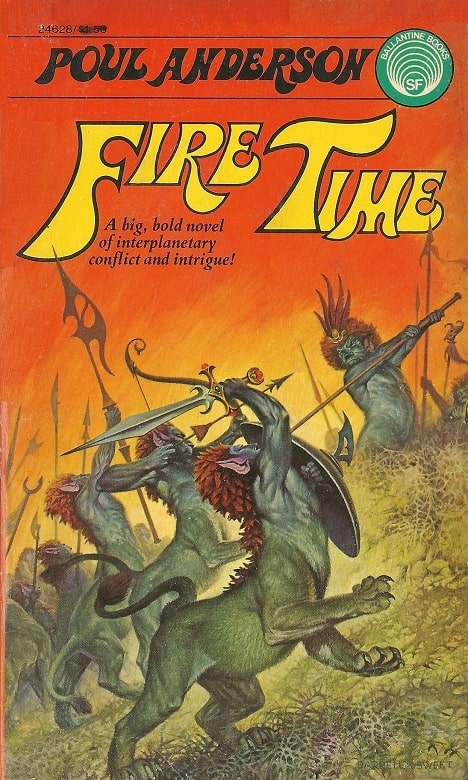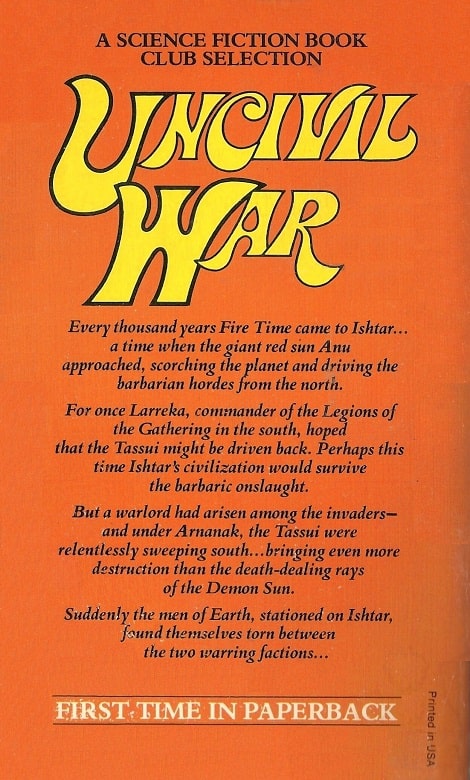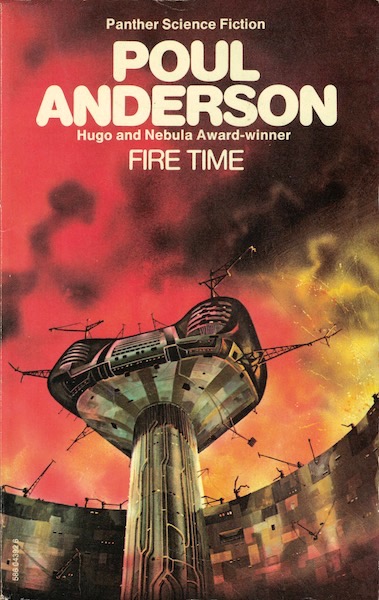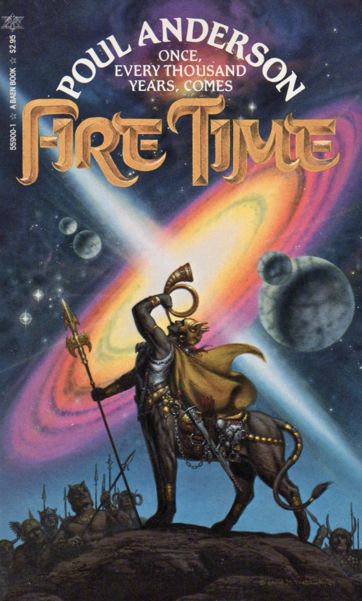Vintage Treasures: Fire Time by Poul Anderson
 |
 |
Fire Time by Poul Anderson (Ballantine Books, November, 1975). Cover by Darrell Sweet
Poul Anderson was a terrifically prolific and popular science fiction writer, in a way I don’t think it’s possible to be today. I mean that in the sense that, yes, he wrote a lot of books — a ridiculous number of books, really. He published hundreds of novels and short stories in his lifetime. (How many, exactly? I have no idea. No one knows. Modern counting methods have failed us. Though there are studious attempts online, and I find this one at Book Series in Order particularly handy.)
But more meaningfully, I mean that every visit to the science fiction section of a well stocked bookstore for the first few decades of my life presented you with dozens of titles by Poul Anderson. Yes, he wrote a lot of books, but unlike most writers his books remained in print — often for decades. He was a reliable presence on bookstore shelves the way Isaac Asimov and Robert A. Heinlein were, or J.R.R. Tolkien and Stephen King are today. In other words, he was a midlist writer who was treated like a bestselling author, and that never happens any more.
I read a lot of Poul Anderson as a result (a lot of folks did). But one book that escaped me, though I was always interested, was his 1974 SF novel Fire Time.
Fire Time was nominated for the Hugo Award for Best Novel in 1975, but lost out to Ursula K. Le Guin’s The Dispossessed (absolutely no shame in that, I might add).
Fire Time is the second novel in what Poul Anderson groupies call the “Gunnar Heim” sequence, presumably because Heim makes a very brief appearance, following his debut in The Star Fox (1965). This is the kind of thing Anderson groupies have made a science of over the years, and it’s probably best not to question it.
[Click the images for fiery versions.]
 |
 |
Later paperback editions of Fire Time: Panther UK (February 1977),
and Baen (August 1984). Covers by Colin Hay and David Mattingly
Fire Time was originally published in hardcover by Doubleday in 1974, and reprinted in paperback by Ballantine in 1975. Ballantine/Del Rey kept it in print for over five years, until it was picked up by Baen, who freshened it up with a new cover by David Mattingly in 1984, and kept it in print for most of the 80s. If you were remotely curious about Fire Time in those days, mighty corporate interests made sure bookstores kept putting it in front of you.
There are plenty of serviceable plot summaries out there, but the one that finally piqued my interest and got me to pick up the book after all these decades was this one, written by Jim at Goodreads in March 2021.
In many ways standard Anderson, which means it’s a good adventure story as well as solid science fiction–with some engaging characters, both human and alien… In this one — and I can’t believe I have not read it until now — Anderson does some great world-building with his planet Ishtar. A small human colony has been established on this Earthlike world. And they have established good relations with some of the aliens of the planet. The Ishtarians are a centaurlike race who are, interestingly enough, superior to the humans in many ways as they are more powerful, faster, and much longer-lived. But they have a major problem — every 1000 years, an event called “the Fire Time” occurs when a giant red star called the “Demon Sun” approaches the planet. The planet is scorched, driving people south and bringing about the collapse of whatever civilization had developed. But, with the help of the humans and their magic technology, the civilized Ishtarians can hope to hold off gathering barbarian hordes and save their civilization. BUT the humans on Ishtar have a problem as well — Earth has gotten into a war with an alien species and it looks like the human colony on Ishtar will be caught in the middle of a war in space, a war they don’t believe in….
Fire Time is still read and enjoyed today. HP at Every Day Should Be Tuesday gave it four out of five stars in 2022, saying in part:
Fire Time takes place on a planet far from Earth. It is the rare planet inhabitable by humans, but their presence is largely limited to scientific work rather than any real colony. The planet is primarily inhabited by sapient lion-centaur creatures with a sword-and-shield level of technology…
It is big, world-spanning stuff, with lots of hard science fiction exposition, but the story focuses on five characters: the military officer sent to enforce the political decisions made back home, two native humans (one male and one female), a lion-centaur military leader from the Gathering with avuncular ties to the female human, and the lion-centaur leading the barbarians.
Fire Time was published almost 50 years ago but remains highly timely, dealing as it does with imperialism and refugee crises and climate change… It’s complex and realistic, recognizing both that politics can make for bad policy and that just because somebody can slap “imperialism” on something doesn’t mean it is bad.
Your Mileage May Vary depending on how hard you want to dork out on the hard social science… my enjoyment being driven by the hard social science fiction aspect and the characterization, both of which are really good.
Michel Siskoid Albert at Goodreads has one of the more interesting modern takes.
Clearly a post-Vietnam novel, Poul Anderson’s Fire Time (1974) questions the validity of war — or certain wars — by giving his story twin wars, both among locals on planet Ishtar, and in the wider universe between humans and another alien species. The war out there affects things “at home” in a way that pushes the characters into difficult choices. But that’s almost an excuse for world-building. In Ishtar, Anderson creates a planet under stress from a three-star system, and imagines how life might have evolved there. We’re often in the Ishtarians’ heads, but there’s little succor from the human characters because the future is an alien place too… once I got my bearings, I wanted to learn more about this intriguing world and see its protagonists safe and successful. And I was kind of sorry to leave Ishtar behind, some of its mysteries unsolved.
Poul Anderson died on July 31, 2001, in Orinda, California, at the age of 74. His obituary famously quoted his wife Karen about the number of books he’d written; saying ““We stopped counting after 100.”
Our coverage of Poul Anderson includes many dozens of articles. Some of the most recent are:
Vintage Treasures: Maurai & Kith (2021)
The Art of Author Branding: The Berkley Poul Anderson (2020)
Humanity Uplifted: Poul Anderson’s Brain Wave by Mark Kelly (2020)
Vintage Treasures: Beyond the Beyond (2020)
There Will Never Be an End to Wonder: James Davis Nicoll on Poul Anderson (2020)
You can find them here.
Fire Time was published by Ballantine Books on November, 1975. It is 246 pages, priced at $1.50 in paperback. The cover is by Darrell Sweet. It has been out of print in the US since 1998, but Open Road Media released a digital edition on November 24, 2015; it’s available on Kindle and other formats for $7.99.
See all our recent Vintage Treasures here.
I just picked up a used Science Fiction Book Club edition of Fire Time off of eBay about two weeks ago. Sitting in my TBR pile but I’m going to move it to the top. Of course, if I hadn’t just bought it, your posting would have compelled me to go out and obtain a copy!
He was incredibly prolific, and not only was his works in print for years, but the overall quality and readability of all his books and stories was better than average. I just finished reading his “The Snows of Ganymede” and it was a really good story, and that’s one of his earlier works. For me, I can honestly say I’ve never been disappointed by a Poul Anderson story. Thanks again for the post.
Mark,
That’s a fine point. Poul Anderson wasn’t just prolific, he was consistently a good writer. And that kept readers coming back for years.
As I mentioned in my article on The Art of Author Branding, the most successful author brands were created around authors with a large following and a deep back catalog, and Poul Anderson had both.
I think that’s primarily why there were ALWAYS paperbacks by Poul Anderson on the shelves when I visited bookstores in my youth. His work was kept in print for years (and often decades), and that’s something that modern readers with similar sales numbers can only dream about these days.
Fire Time sounds interesting. I’ve only read a tiny fraction of Anderson, which is to say I’ve read Tau Zero, Orion Shall Rise, Starfarers, No Truce with Kings, “The Saturn Game,” “The Longest Voyage,””My Object All Sublime” … and I think I’ve read The Broken Sword, though my memory on that one is hazy and if so I’m not sure if I read the 1954 version or the 1971 version, which I hear are substantially different from each other. So I should pick a version and start again!
Chris,
That’s a humble statement, but it sounds like you’ve read more Poul Anderson than I have in the past ten years. And that’s a fine selection! No Truce With Kings is probably my favorite of the titles you listed.
What did you think of his later books, like Orion Shall Rise and especially Starfarers?
John, I read Orion Shall Rise in my personal Golden Age of science fiction and I loved it. I’d be hard-pressed to tell you exactly what happened, though; it’s been a long time. I remember an interesting post-post-apocalypse setting. What I mean is, it’s not a Mad-Max style survival situation; various places have recovered enough to rebuild a technological base and give their citizens a safer life. But the new civilizations are very different from each other. I think there’s a quasi-medieval technocracy going on in Europe, and an environmentally-minded New Zealand-based region centered on Maori culture. There’s a lot of suspicion of technology, though, so when someone tries to start a new space program, there is a big conflict. (I think there are other conflicts going on, but I’m fuzzy on the details.) I’m sure I’m not doing it justice, but I remember being fascinated by all the different societies.
Starfarers I read later and it’s a solid jolt of sense-of-wonder science fiction. Humans detect evidence of an advanced civilization elsewhere in the galaxy, but the “Yonderfolk,” as the humans dub them, are not trying to communicate — what humans see is evidence of their relativistic starships passing through the interstellar medium. This evidence helps Earth build relativistic starships of its own, and it sends one to make contact. This is a no-FTL universe, so while the crew may see Earth again, it will be thousands of years later and so there’s no going “home,” really. The crew is a bunch of obsessive adventurer-types (and packing a bunch of such people in close proximity does cause some serious problems) who just have to see what’s out there. I really enjoyed the ride. My only quibble is that the book felt too short to me — and it’s a pretty thick book, so that shows you how much I liked it. If you like exploration-style science fiction this is a great example.
Side note — Vonda N. McIntyre coincidentally had a book named Starfarers, which I read about the same time because I have a weird habit of reading books back-to-back that share a theme, and which is *also* solid sense-of-wonder science fiction, and which I also recommend. Plus there are equally great sequels.
Extra side note — Artist Wayne Douglas Barlowe put a painting of the aliens from Fire Time into his Barlowe’s Guide to Extraterrestrials, which I wish I still had a copy of!
This is one of my favorites among Anderson’s works, great to see it featured on Black Gate! I’ve always loved his world building, he’s great at taking science and spinning gripping stories from it.
Thanks, Dariel. I don’t see Fire Time discussed among Anderson’s work much (not the way The Broken Sword is, for example), so it’s great to see it still has fans.
I recognize that bright orange cover. I think I have it in a bundle of books I received from my Aunt a couple of years ago. I remember it because the yellow lettering really stood out on the orange background. I’ll have to pull it out and give it a read as it sounds intriguing.
Joanna,
So true! The color scheme for this cover is so striking that you can pick it out from across the room. Every author dreams of having a book that’s as instantly recognizable as Fire Time!